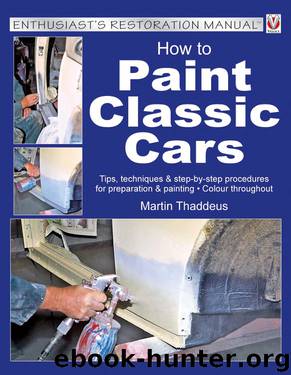How to Paint Classic Cars by Martin Thaddeus

Author:Martin Thaddeus
Language: eng
Format: epub
Publisher: Veloce Publishing Ltd
Published: 2014-12-19T05:00:00+00:00
Onion-type filler mixing board.
Tips
Keep as much of the block in contact with the panel as possible. Move it diagonally across the line of the panel, and try to roll with the contour. Use a stroke which takes in as much of the contour as is necessary to give a true account of the shape.
When trying to reconstruct a swage line, it may be helpful to draw the line in pencil or to blow a line of primer over the swage area to highlight the line. Work on one side of the line and then the other.
Filler used on GRP (glass fibre) bodywork.
Oblique lighting from a hand held neon light is the best tool for revealing flaws in tricky compound curves. Dim the ambient lighting and hold the wander light alongside the repair. Now move the light up and down while watching the fringe of shadow as it traverses the repair. A coat of primer over the repair will help reveal any flaws, as this will prevent distraction from the various surface colours.
When feeling for the shape by hand, keep the palm flat against the panel and the fingers extended. Moving the hand in the same way as you did the block (in as many directions as possible) means you’re more likely to pick up on lows and highs. Be sure to take in the surrounding panel, as it’s all to easy to produce a perfectly contoured repair which does not mate to its surroundings.
A thin cloth or glove interposed between hand and panel will allow you to feel the contour, but not the various textures of paint, metal and filler which might lead to some sensory confusion.
Pay particular attention to your fingertips as you push you hand forward, they will give you a lot of information.
As a skill, filling takes time to perfect, and the only way to learn it is to get stuck in. Ask for the opinions of those around you (get friends and family to feel the repairs, for example), and only move on to priming when you’re completely happy. Of course, priming doesn’t mean that you can’t continue the shaping process; indeed, a wet coat of primer will reveal a lot about the state of your repairs; particularly the edges. Once dried, the primer will act as a reveal for any highs and lows if you continue to block with a fine paper.
Download
This site does not store any files on its server. We only index and link to content provided by other sites. Please contact the content providers to delete copyright contents if any and email us, we'll remove relevant links or contents immediately.
| Automotive | Engineering |
| Transportation |
Machine Learning at Scale with H2O by Gregory Keys | David Whiting(3984)
Never by Ken Follett(3716)
Urban Outlaw by Magnus Walker(3312)
OPNsense Beginner to Professional by Julio Cesar Bueno de Camargo(3230)
Sapiens and Homo Deus by Yuval Noah Harari(2951)
Will by Will Smith(2745)
A Short History of Nearly Everything by Bryson Bill(2585)
Hooked: A Dark, Contemporary Romance (Never After Series) by Emily McIntire(2470)
Rationality by Steven Pinker(2235)
Borders by unknow(2155)
Holy Bible (NIV) by Zondervan(2059)
The Becoming by Nora Roberts(2038)
The One Percenter Encyclopedia by Bill Hayes(1764)
Freedom by Sonny Barger(1747)
HBR's 10 Must Reads 2022 by Harvard Business Review(1744)
A Short History of War by Jeremy Black(1732)
Five Ways to Fall by K.A. Tucker(1668)
Girls Auto Clinic Glove Box Guide by Patrice Banks(1657)
Go Tell the Bees That I Am Gone by Diana Gabaldon(1655)
